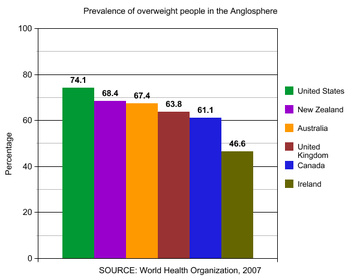Obesity in New Zealand

Obesity in New Zealand has become an important national health concern in recent years, with high numbers of people afflicted in every age and ethnic group.[1] As of June 2008, 26.5% of New Zealanders are obese,[1] a number only surpassed in the Anglosphere by the United States.[1][2]
Prevalence of obesity in New Zealand's population
New Zealand's adults
Out of a total estimated population of 4.3 million in 2008,[3] the Ministry of Health's studies show that roughly 1.13 million New Zealand adults are overweight (BMI between 25.0 and 29.9),[4] with an extra 826,000 obese (BMI over 30.0).[4] The 2008 figures, which represent samples from 2006 and 2007, show that 25% of New Zealand adults are obese, a slight increase from 2002 and 2003 (24%) but a wide rise from 1997 (19%).[1] If current trends are to continue, the obesity rate will rise to 29% by 2011.[5]
Obesity is more prevalent in New Zealand females from age 5 until the age of 34, at which time the males overtake the females in terms of percentage.[1] After essentially coming in at a dead heat in the 55 to 64 bracket, female obesity becomes a higher risk for 65- to 74-year-olds than it does for males, only to switch odds again after 75.[1]
New Zealand's children
As of 2004, over 30 percent of children in New Zealand were classified as overweight.[6] In the 2008 figures, 8.3% of children ages 5 to 14 in New Zealand were classified as obese.[1] While more numerous than the same demographic in Australia (between 5 and 6%),[7] the number of obese children actually declined from a record high of 9% set in 2002.[1] Starting in 2006, the government has worked to cut high-fat foods and high sugar drinks from school cafeterias, and also to curb advertising for junk food during daytime television hours, these moves are being credited with slowing the rate of obesity in New Zealand, especially among the young.[8]
Māori, Asians and Pacific Islanders
In the 2008 report, adults of Māori and other Polynesian descent had a much higher rate of obesity than white New Zealanders.[1] The rate for the Pacific peoples were nearly triple the white average, while Māori reported nearly double the white rate. 65% of adult Pacific New Zealanders and 43% of adult Māori were obese, compared to 23% of white adults.[1] 12% of Asian New Zealanders were obese. Out of all the ethnic groups surveyed, only the Asians reported a large increase in obesity from the 2002 statistics.[1]
See also
References
- 1 2 3 4 5 6 7 8 9 10 11 "Obesity - Social Report 2008". Ministry of Social Development. 1 June 2008. Retrieved 2009-07-05.
- ↑ Lauren Streib (8 February 2007). "World's Fattest Countries". Forbes. Retrieved 2009-02-12.
- ↑ "National Population Estimates: March 2009 quarter". Statistics New Zealand. 15 May 2008. Archived from the original on 23 May 2009. Retrieved 2009-05-20.
- 1 2 "Question and Answer - Obesity". 1 June 2008. Retrieved 2009-07-05.
- ↑ Martin Johnston (23 November 2005). "Skipping meals a slimming dud". The New Zealand Herald. Retrieved 2009-07-05.
- ↑ "New Zealand to adopt 'traffic light' anti-obesity campaign". The Canadian Press. 31 August 2007. Retrieved 2009-07-05.
- ↑ Mandy Biggs (5 October 2006). "Overweight and obesity in Australia". Parliament of Australia. Retrieved 2009-07-05.
- ↑ "New Zealand slashes obesity levels". The Associated Press. 4 June 2008. Retrieved 2009-07-05.